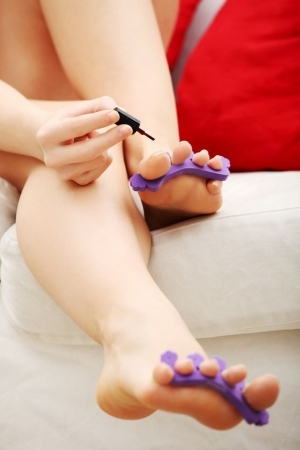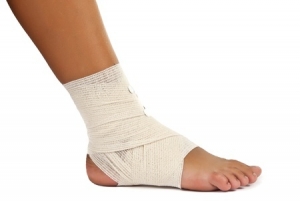Connect With Us
Blogs
Keep it Moving for a Healthy Heart
February is American Heart Month and at Superior Foot & Ankle Care Center we know that your feet and your heart have a loving relationship. A healthy heart means good circulation which is beneficial to your feet. Your feet play an important role in a key element of heart health: staying active. We want our Los Angeles County patients to know that regular physical activity is one of the best ways to reduce your risk of heart disease. The American Heart Association recommends adults get in 150 active minutes (2.5 hours) each week. In addition to keeping your heart healthy, there are other benefits of an active lifestyle including:
- Reduced risk of other diseases such as stroke, diabetes, high blood pressure, dementia, and several types of cancer
- Help with weight loss or maintaining an appropriate weight
- Better sleep
- Less anxiety and depression
- Improved bone strength and balance, which decreases fall risk
- Mental sharpness: improved cognition, attention, processing, and memory
Help Your Feet Help Your Heart
For your feet to be able to help you stay active, they too need care and attention. Follow these tips to ensure that your feet and ankles are in tip-top shape for physical activity.
Take Care of Foot Pain—continuing to work out if your feet or ankles hurt is a bad idea. Any podiatric discomfort should be evaluated by our podiatrists, Dr. Victoria M. Foley and Dr. Constance Ornelas. The foot doctor will examine your feet and diagnose any problems that will impede your ability to be active. Your podiatrist can also make recommendations to help you accommodate chronic foot problems like plantar fasciitis and bunions. Shoe modifications, custom orthotics, and other recommendations can help. Make an appointment by contacting our Long Beach office at (562) 420-9800.
Choose Shoes Wisely—what you wear on your feet can have a big impact on the success of any fitness regimen. Be sure the athletic footwear you are using is the right kind for the activity you’ve chosen. Check shoes regularly for signs of wear such as compacted insoles, worn down heels, and rips or tears. Get your feet professionally measured to ensure you’re wearing the correct size.
Mix Up Your Routine—choose a variety of different types of activity each week. A mix of aerobic and strength training will benefit your heart and avoiding repetitive strain and impact is good for your feet.
If you have additional questions about heart health, fitness, and your feet, contact us today.
Healthy Foot Habits for the New Year
January is a time for making a fresh start and resolving to make positive changes. At Superior Foot & Ankle Care, we’d like to encourage our Los Angeles County patients to take some steps to ensure healthier feet and ankles in 2021. Below are some easy tips to implement:
- Commit to a Basic Hygiene Regimen—Did you know that simply washing your feet daily with soap and water and drying them thoroughly can significantly reduce your risk of fungal infections? If you add a dusting of a foot or fungal powder in the morning and a rich moisturizer at night before bed, you’ve got a fast and effective foot care plan.
- Check Your Feet for Changes—It’s easy enough while you’re cleaning your feet to look them over for any symptoms that may signal a developing problem. Check for toes that appear to be moving out of place, bruises, swelling, wounds that are slow to heal, discoloration of skin or nails, and any growths or lumps. If you notice something concerning, contact our Long Beach office by calling: (562) 420-9800 to make an appointment with our podiatrists, Victoria M. Foley and Dr. Constance Ornelas, to examine your feet and diagnose any problems.
- Keep Up with Nail Care—Trim toenails regularly and file any rough edges to prevent them from getting caught and tearing. Always cut nails straight across and be careful not to make them too short or they will be in danger of becoming ingrown.
- Choose Shoes Wisely—One of the single biggest steps you can take to prevent many common foot disorders is wearing good shoes. Look for styles that are made of soft, flexible material and have roomy toe boxes. Good arch support and a cushioned insole are also important. Limit time spent in high heels as these can harm your feet and cause bunions, hammertoes, and other deformities.
- Make Healthy Lifestyle Choices—Regular exercise, a healthy diet, and getting enough sleep all impact the condition of your feet as well as the rest of your body. Don’t try to change everything at once. Small changes that you can sustain will have big payoffs in the New Year!
If you have questions about the care of your feet, don’t hesitate to contact us.
Holiday Season Do’s and Don’ts for Healthy Feet
Although the radio may be proclaiming “It’s the Most Wonderful Time of the Year,” we at Superior Foot & Ankle Care Center know that the feet of our Los Angeles County patients may not agree. It’s a time of year with lots of extra errands to run, cooking and shopping to do, and being on your feet for longer periods than usual. However, you can sail through the season feeling “merry and bright” if you follow the do’s and don’ts below to keep your feet and ankles healthy and pain-free.
Do: go easy on holiday feasting. Yes, there will be lots of delicious sweets and treats on the menu, but come January extra weight gain could result in added stress and pain for your feet. Many common conditions such as plantar fasciitis, sesamoiditis, and metatarsalgia are all aggravated by carrying additional pounds. If you suffer with diabetes or gout, you need to pay particular attention to what you put on your plate. Go for small quantities of your favorites to savor and compensate by not loading up on unnecessary carbohydrates. Avoid going back for seconds!
Don’t: allow your feet to stay in damp socks. Whether you’ve stepped in a puddle or your feet are sweating during a long day of shopping, it’s essential to not let feet stay where it’s moist. Damp, dark, closed-in spaces (like the insides of your shoes) are the perfect breeding ground for fungal infections. Pack an extra pair of socks and change into them when you notice feet feel sweaty. Use foot powder before you put on socks.
Do: carefully consider footwear choices. When you know you’re going to be on your feet for several hours or doing an above-average amount of walking, make sure the styles you choose are comfortable and have good arch support and non-stick treads. Limit the amount of time in high-heeled party shoes!
Do: leave extra time in your schedule for making appointments. Rushing is when you’re most likely to not see an object in your path which can cause an ankle sprain or other injury.
Don’t: put off getting foot pain evaluated by our podiatrists, Dr. Victoria M. Foley and Dr. Constance Ornelas. This can result in a podiatric problem getting worse and potentially requiring longer and more invasive treatments. Make an appointment at our Long Beach office by calling: (562) 420-9800 today.
8 Ways to Protect Your Feet if You Have Diabetes
November is American Diabetes Month and at Superior Foot & Ankle Care Center this is a topic of high importance. Diabetes has the potential to seriously impact the health of your feet. When blood sugar levels are high, your immune system can be compromised, and your body may have difficulty fighting infections. Two other conditions associated with diabetes—poor circulation and peripheral neuropathy (loss of feeling) — can conspire to put your feet at risk for dangerous wounds and infections. Diabetes can also affect your bones, joints, and skin. This year’s message from the American Diabetes Association, however, is one of hope: “We Stand Greater Than Diabetes.” The good news is that there are many ways to prevent podiatric problems if you have diabetes. Below are eight to consider:
- Schedule regular podiatric exams. Our podiatrists, Victoria M. Foley and Dr. Constance Ornelas, are an important part of your health care team if you have diabetes. Seeking care regularly will help the foot doctor spot problems before they get out of control and help you be proactive in protecting your feet.
- Check your feet daily. Getting in the habit of examining your feet—top, bottom, between the toes and toenails—will enable you to spot any changes promptly. Cuts that aren’t healing, redness, swelling, bruising, growths, or changes in skin color or nails may all be signs that something potentially harmful is developing. Any changes should be reported promptly to our Long Beach office by calling: (562) 420-9800.
- Choose your shoes carefully. Avoid stiff shoes and look for styles that have roomy toe boxes. Get your feet measured and fitted professionally and periodically run your hand around the inside of the shoes to make sure there are no rough seams or material that could cause friction and blisters.
- Don’t smoke. It impedes circulation.
- Keep feet dry. Sitting in damp footwear can increase your risk of athlete’s foot and fungal toenails.
- Don’t go barefoot. Even at home, wear slippers or shoes to prevent cuts and puncture wounds.
- Do not use medicated pads, acid solutions, or sticky pads. For warts, corns, and calluses consult your podiatrist for treatment and don’t attempt any “bathroom surgeries.”
- Follow your doctor’s instructions for managing your diabetes. Take your medications as directed, eat a nutritious diet, maintain a healthy weight, and exercise regularly.
Foot Disorders that Sound Scary (but Aren’t!)
At Superior Foot & Ankle Care Center we thought we’d get into the spirit of Halloween for our Los Angeles County patients by exploring some foot problems that have frightening names. If our podiatrists, Dr. Victoria M. Foley and Dr. Constance Ornelas told you that you had one of the disorders named below, you might panic. But in reality, these are just the medical names for some fairly common and easily treatable conditions. And, our friendly podiatrists would most likely tell you the “user-friendly” name of your foot problem to avoid alarming you!
Tinea Pedis—You’d probably be less scared if you heard “athlete’s foot,” the common name for this itchy skin problem. Often beginning between your toes, the skin will be red, itchy, and flaky. In advanced cases, oozing blisters and cracks in the skin may develop. There are a number of topical treatments that the foot doctor may prescribe to eliminate athlete’s foot. Of course, it’s better to avoid contracting it in the first place. To prevent athlete’s foot, wear shower shoes when walking in public places like community pools and gyms, avoid items that touch another person’s foot, and keep feet dry.
Medial Tibial Stress Syndrome—You may experience this podiatric problem if you’ve recently started a new walking or running program. Its shorter name is “shin splints.” Telltale signs include pain, swelling, and tenderness in the front of the leg on either side of the shin bones. It’s important that you have your legs and feet examined by the foot doctor if you have shin splints because there are a number of different causes of this condition. Left untreated, the pain will get worse and may even lead to a stress fracture.
Onychomycosis—What does it mean when your toenails become discolored and get thick and crumbly? Most likely you’ve contracted toenail fungus—also known as onychomycosis. Fungal toenails are harder to get rid of than other fungal infections. The foot doctor will prescribe the best treatment option for you. We also offer KeryFlex Nail Restoration System to repair nails damaged by fungal infections.
We don’t ever want any of our patients to be fearful about seeing the podiatrist. If you notice anything that looks even a little frightful about your toes, feet or ankles make an appointment at our Long Beach office today by calling: (562) 420-9800.
Enjoy an At-Home Pedicure
At Superior Foot & Ankle Care Center, we know the coronavirus has made life very stressful for our Douglas Park/Los Angeles County area patients, and we hope everyone is doing their best to stay safe and healthy. One suggestion we have if you are staying in your home is to treat yourself to a pedicure—home style. Taking care of yourself helps maintain good health and a healthy attitude.
An at-home pedicure is also relaxing and soothing. Just follow these 9 simple steps:
- Find a quiet place in your home. Put on some soft music and light a scented candle. Try to have all our tools gathered before you start.
- Remove old nail polish using nail polish remover and cotton balls.
- Soak your feet in a basin of warm, soapy water. Add some essential oils to the water if you have them. Using a soft nail brush, gently scrub your toenails. Rinse feet with clean water. For patients with diabetes, you should now skip to step 7. Cutting nails and cuticles should be handled by our podiatrists, Victoria M. Foley and Dr. Constance Ornelas, to avoid possible injury or infection.
- Exfoliate dead skin from rough areas on the heel and ball of the feet using a pumice stone or foot file. Wipe feet clean.
- Trim toenails straight across. Be careful not to cut nails too short, or this can cause an ingrown toenail to develop. File smooth, but don’t round the edges.
- Use an orange stick to push back cuticles gently. Carefully trim if needed, being careful not to cut too aggressively, so they bleed.
- Massage a rich moisturizer into your entire foot. Take your time! Massage eases aches and tension and feels so good.
- Remove any leftover lotion from toenails with nail polish remover.
- If you’d like, apply a base coat, your favorite spring color, and a topcoat, allowing ample time between coats for nails to dry.
If, during the course of your home pedicure, you notice anything unusual about the appearance of your feet, contact our Long Beach office by calling: (562) 420-9800 to confer with one of our podiatrists.
Now’s a Good Time for Family Fitness Fun
At Superior Foot & Ankle Care Center, we know that staying home is the best way for our Douglas Park/Los Angeles County area patients to prevent the spread of the coronavirus, but it can also cause everyone in your family to get a case of cabin fever. One way to break the boredom and do something good for yourselves is by enjoying some sports and fitness activities together. Exercise has many benefits for parents and children:
- Helps burn calories to maintain a healthy weight
- Plays a role in preventing many diseases such as diabetes, heart disease, and arthritis
- Improves sleep quality
- Decreases stress and improves mood
Who can’t get behind all of those right now?! Who knows, you may find new ways to enjoy family time and stay fit that you’ll want to continue after the coronavirus is long gone.
Start with the Basics
A good exercise program will start out slowly and gradually build in intensity and duration. Other tips before you begin:
- Make sure everyone has the proper footwear. Shoes that fit properly and are designed for fitness activities are a must.
- Get the green light on previous foot problems. If you or someone in your family suffers from a chronic foot condition such as heel pain or a weak ankle, contact our Long Beach office by calling, (562) 420-9800. Our podiatrists, Victoria M. Foley and Dr. Constance Ornelas may want to discuss the best types of exercise to prevent your condition from worsening and any special accommodations you should make.
- Warm-up and stretch at the beginning of your activity session and end with a cool down to prevent injuries.
Explore New Activities
Get the whole family involved in choosing what types of activities you’ll do. Have everyone write down something they want to try (yoga, biking, etc.) using gear you already own. Put them in a basket and draw one out at a time and try them out.
Stuck indoors? Go online for fitness classes, learn about training with weights (use canned goods if you don’t have enough weights) or create an indoor exercise circuit.
Most importantly, have fun and stay safe! If you have questions about fitness and your feet, don’t hesitate to contact us.
TeleHealth or EVisits
Dear Valued Patient,
To limit the spread of COVID-19 and respect social distancing, Superior Foot & Ankle Care Center can provide Tele-Health and E-Visits.
- Medicare and other Health Insurance Companies have expanded covered benefits to include the use of Tele-Health or E-Visit services.
- Tele-Health visits include the use of phone calls, video calls, and e-mail that support long-distance or at-home clinical healthcare.
- Our office will be using Skype and Face-time to conduct these calls. A staff member will call at the time of the appointment to confirm your phone number and whether you have an iPhone or Android device.
- You get healthcare from the safety and comfort of your own home using your cell phone, tablet, or personal computer.
- While we know that some conditions may still require an in-office visit/exam, we want to make sure patients have access to proper treatment during this emergent pandemic.
If you have questions or are interested in Tele-Health services, please call our office at 562.420.9800.
Sincerely,
Victoria M. Foley, DPM, FACFAS
Constance J. Ornelas, DPM, FACFAS
FAQ’s about Chronic Ankle Problems
At Superior Foot & Ankle Care Center, we often find that our Douglas Park/Los Angeles County area patients with ongoing ankle issues assume that this is a condition they have to live with. Not so! Below are some frequently asked questions about chronic ankle pain and instability, including how to best treat it.
What are the signs of a chronic ankle condition?
Chronic ankle conditions may manifest in several ways, including:
- Feelings of weakness or instability in the ankle
- Frequently turning of the ankle
- Pain or tenderness
- Joint stiffness
- Swelling
These symptoms may come and go, but that doesn’t mean they should not be evaluated by our podiatrists, Dr. Victoria M. Foley and Dr. Constance Ornelas.
Why does chronic ankle pain and weakness occur?
Most often, recurring ankle problems are the result of an ankle sprain that did not fully heal. Other causes are:
- Scar tissue
- Ankle joint bone fractures
- Arthritis
- Inflammation of tendons or joint lining
- Nerve damage, such as tearing, pinching, or stretching of the ankle nerves.
The wide range of possible causes is why you need to have ankle discomfort evaluated. Make an appointment at our Long Beach office by calling: (562) 420-9800.
How is chronic ankle pain and instability treated?
The treatment for an ongoing ankle issue will depend on the root cause of the discomfort and the severity of the condition. The foot doctor may prescribe anti-inflammatory or steroidal medications temporarily to relieve swelling and inflammation. Ankle braces and supports can help keep your ankle stable. Physical therapy and exercise can strengthen supporting muscles and improve flexibility and range of motion. In some cases, surgery may be warranted.
It’s important not to put off seeking treatment for chronic ankle problems. If you do, chances are they will only get worse. If you have any troubling symptoms or concerns about your ankle, contact us today.
Dear Valued Patient
Superior Foot & Ankle Care Center has been closely monitoring information and recommendations from the CDC and CA Department of Health about the COVID-19, Coronavirus. Even before the outbreak, our medical staff already used standard infection control practices.
In accordance with current guidelines and recommendations, we have put extra protocols in place to reduce risk to our patients and medical staff members.
- We ask that any patient or family member, that displays symptoms such as cough, fever, shortness of breath, to reschedule appointments until they are free from symptoms for at least 24 hours. We ask this of our medical staff members as well.
- We are asking patients to cooperate in a rescheduling effort for non-emergency appointments.
- We are asking that all patients call our office when they arrive in the parking lot for their appointment. We will then call you back when we are ready for you to come in and have you go directly to a patient room.
- We are trying to limit the number of people in the office at any one time to 10 people. You may bring one additional person with you to your appointment (i.e. caregiver or parent of the child) if necessary.
- Dr. Foley and Dr. Ornelas will be available by phone for consultations if needed.
CDC recommends to take everyday precautions to prevent the spread of respiratory illnesses, including COVID-19 and influenza, by doing the following:
- Cover your coughs and sneezes with a tissue and then throw the tissue in the trash.
- Wash your hands often with soap and water for 20 seconds. If soap and water are not readily available, use an alcohol-based hand sanitizer that contains at least 60% alcohol.
- Avoid close contact with people who are sick.
- Avoid touching your eyes, nose, and mouth with unwashed hands.
- Clean and disinfect surfaces that are often touched.
- Take care of your health overall. Staying current on your vaccinations, including flu vaccine, eating well and exercising all help your body stay resilient.
- Consult the CDC’s travel website for any travel advisories and steps to protect yourself if you plan to travel outside of the US.
For more information, check out the following:
- The CDC COVID-19 page.
- The CDC travel notice.
Sincerely,
Victoria M. Foley, DPM, FACFAS
Constance J. Ornelas, DPM, FACFAS










